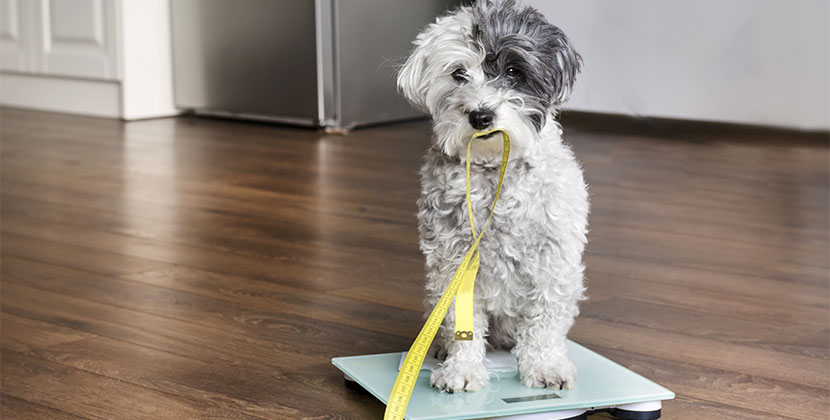
DogFoodAdvisor is reader supported See how
Dog Food Advisor is 100% impartial and is never paid to promote any brand. But if you buy using links on this page, we may earn a referral fee.
While we love having things in common with our dogs, such as our fondness for cuddling or walks on the beach, it can become a problem when our health issues extend to our furry friends. This includes obesity — arguably the biggest health risk dogs.
The United States struggles with a weight problem among its human population — and it’s reported that nearly 60% of dogs in the USA are also overweight or obese 1
This issue persists in part because many pet parents don’t recognize their beloved pets are carrying excess weight, which comes with serious health issues. Further, many may not take action until it manifests as one of those issues.
Thankfully, there are solutions available — and awareness is the first important step. We asked Dr. Brandon Stapleton, DVM, the head veterinarian at 5-star-rated The Farmer’s Dog, for his advice on determining if your dog is overweight and how to tackle weight issues.
Why is it dangerous for dogs to be overweight?
“Obesity in dogs is one of the biggest health threats for our pets,” says Dr. Stapleton. “It’s important to understand the seriousness of the condition and that it’s not just about their appearance — it can have severe physiological consequences. Being overweight or obese is linked to many other health issues including arthritis, chronic kidney disease, liver disease, diabetes, heart failure, and many more life-threatening conditions.”
Research shows that dogs kept at a healthy weight and lean body condition can live 2.5 years longer than heavier dogs.
Is my dog overweight?
First things first (before scaring you completely) — is your dog overweight and how can you tell?
“The issue many pet parents have is not realizing their dog is overweight at all,” says Dr. Stapleton. “A healthy dog may look a bit leaner than people think. And the margins are slim — we may think of a few extra pounds as no big deal for ourselves, but for dogs, even a seemingly small amount of extra weight can cause health issues.”
An additional three to four pounds is especially consequential for a smaller dog, but dog parents may hear these “small” numbers and think of it in cosmetic terms.
It’s important to understand the correct weight for your dog’s breed and age. The best thing you can do is speak to your veterinary care team about what an ideal weight looks like for your dog. Your veterinarian will weigh your dog, establish a body condition score and a muscle condition score, and share insights about whether your dog needs to lose, gain, or maintain weight.
The key is to pay attention to any advice on weight loss, even if it’s “just” a few pounds — these small amounts can make a big difference to their health.
If you’re concerned about your dog’s weight, visiting the vet for a health check will get you the best results. However, you can also perform a body condition test at home.
Look at and feel your dog’s ribs, feeling all along their rib cage. Take a look at their shape from above and from the side. Gently run your hands down your dog’s body from their rib cage to their hips. Here are some signs that your dog is overweight that you can glean from the test:
- Difficulty feeling ribs: You should be able to feel, but not see your dog’s ribs. Ribs should be easily felt beneath a thin layer of fat and skin. If you need to push very firmly to feel your dog’s ribs, they might be overweight.
- Loss of waist definition: Instead of a discernible waist, an overweight dog may look and feel cylindrical or barrel-shaped when viewed from above. The rib cage and pelvic area should be wider than the waist/belly area.
- Lack of abdominal tuck: A visible abdominal tuck, where the abdomen is higher than the chest when viewed from the side, is a sign of a healthy weight. If you see and feel a straight line from your dog’s stomach to their back legs, or if their stomach hangs down, they are overweight.
It can be more difficult to determine body condition with longer-haired or larger dogs so it’s a good idea to seek professional advice to determine their ideal body condition. Your vet can also provide insight into changes in muscle condition. Dogs who are overweight or have underlying health issues may show muscle loss, which has an impact on their strength, their immunity, and more.
What to do with an overweight dog?
So, you’ve discovered your dog is overweight. The good news is you control your dog’s food intake, so you can do a lot to help.
“As with humans, helping an overweight dog primarily comes down to diet,” says Dr. Stapleton.
Understanding exactly how much to feed your dog is essential. Like many experts, Dr. Stapleton recommends working with your vet to assess your dog’s body and muscle condition, lifestyle, and how many calories they should eat.
The issue with sticking to the guidelines on traditional dry dog food packaging is every dog is different, and feeding instructions are usually given as a weight range that corresponds to a portion range (usually measured in cups or scoops).
Those ranges are where much of the problem lies — they allow too much room for overfeeding (and studies show that dog parents often overestimate kibble portions). When it comes to daily portions, it’s important to be precise; that means knowing how many calories your dog should consume each day. Subscribing to a pre-portioned food plan (such as The Farmer’s Dog) makes this easier.
And while diet is the most important factor in weight management, for all dogs, daily exercise is also critical to a healthy weight and maintaining lean muscle mass, not to mention promoting mental and physical health.
For a more extensive guide on how to help your dog lose weight, check out our in-depth article here.
Maintaining a healthy weight: Practical tips for dog parents
It’s a good idea to establish and maintain good habits when it comes to your dog’s diet and lifestyle.
With help from Dr. Stapleton, here are some general tips that contribute to giving them a good quality of life and a longer healthspan:
- Routine vet check-ups: Schedule regular veterinary check-ups to monitor your dog’s weight and address any concerns promptly.
- A high-quality diet: Provide a well-balanced, high-quality diet tailored to your dog’s breed, size, age, and activity level.
- Portion precision and control: Be mindful of portion sizes and avoid overfeeding. Consult your vet for specific feeding guidelines, or sign up for a pre-portioned food plan that takes into account your dog’s unique needs.
- Regular exercise: Incorporate regular exercise into your dog’s routine to keep them active and maintain a healthy weight.
- Healthy treats: Opt for healthy treats and limit extras to no more than 10% of daily calories.
Maintaining your dog’s optimal weight is a fundamental aspect of being a responsible pet parent. Regular monitoring, a healthy, correctly portioned diet, and appropriate exercise contribute to a healthy, happy dog.
Final word
The Dog Food Advisor does not accept money, gifts, samples or other incentives in exchange for special consideration in preparing our reviews.
However, we do receive a referral fee from online retailers (like Chewy or Amazon) and from sellers of perishable pet food when readers click over to their websites from ours. This helps cover the cost of operation of our free blog. Thanks for your support.
For more information, please visit our Disclaimer and Disclosure page.
Article reviewed by
Andrew Dickens
Editor
Andrew Dickens is an award-winning writer, editor and broadcaster with 20 years in journalism. He’s created compelling content on film and television, travel, food and drink, physical and mental health, business, sport, technology and politics. And, of course, dog food.




